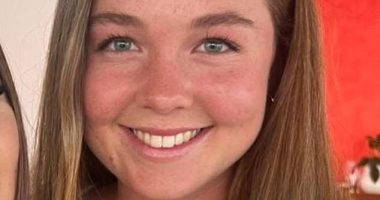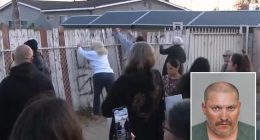Wild rain bomb will be worse than predicted with warnings of flooding and up to 200mm of rain – here’s what it will be like near you
- Rain bomb expected to hit NSW, ACT
- Rainfall could potentially top 200mm
<!–
<!–
<!– <!–
<!–
<!–
<!–
Millions of Australians have been warned to batten down the hatches with a predicted rain bomb becoming more intense than previously expected.
The nation’s east coast is expected to be smashed with rain over the weekend with NSW and the ACT facing the brunt of the wet weather and some areas south of Sydney potentially receiving 200mm of rain.
The Bureau of Meteorology say the deluge of rain is being caused by a low pressure system developing off the coast of NSW.
The rain is expected to sweep across the nation’s south-east through Melbourne and Hobart before crossing over Canberra and Sydney.
The heavy rain has resulted in the SES issuing a warning that landslides and flash flooding are possible in the event of heavy rain.


Millions of Australians have been urged to take care over the weekend with a massive rain bomb expected to hit the nation’s east coast
Previous predictions saw a much more narrow area of heavy rainfall predicted, however with the low pressure system advancing on the coast it is expected to now cover a broader area.
‘We are expecting showers and possible storms across a much broader stretch of the east coast,’ Miriam Bradbury, BOM meteorologist, told the Today Show.
While NSW, the ACT and southern parts of Queensland are expected to experience some heavy rain, south of Sydney is expecting a much more grim forecast.
Sky News Meteorologist Rob Sharpe said: ‘Sydney will be quite wet on Saturday and Sunday but it’s just south of there that looks like being the target zone.’
A zone of heavy rain that could deliver as much as 200mm of rain could potentially hit areas around Canberra and Batemans Bay.
‘One area of particular risk for heavy rain and flooding will be the southern half of the NSW coast and adjacent ranges, where a focused stream of onshore winds could produce more than 100mm of rain and possibly more than 200mm in some places,’ Weatherzone said.
Other rainfall totals forecast for the NSW south coast include 75mm in Wollongong could see across the weekend, 125mm for Nowra and 150mm at Ulladulla.
Alongside the heavy rain, temperatures are expected to drop by about 2C across the southern half of Australia and expected to hold until Sunday afternoon.


Areas south of Sydney including Canberra and Batemans Bay are expected to face the brunt of the rainfall with some areas potentially receiving 200mm of rain
The NSW SES has put residents on alert, warning that flash flooding and landslips are possible with the deluge of rain forecast.
‘It is important to prepare your home and items ahead of this forecast, by tying down loose items, parking your car undercover, away from trees and cutting branches that could cause damage to your home,’ State Duty Commander Assistant Commissioner Nicole Hogan said.
‘Driving during and after a storm can be very dangerous. If you can, delay your trip, and park under cover.
‘If you do need to drive, never drive, walk or ride through flood waters.
‘If you come across a flooded road, please do not take the risk and find an alternate route.’


The heavy rainfall prediction has caused the SES to issue a warning of flash floods and landslips
Brisbane is expected to receive scattered showers on Saturday that should pass for a dryer Sunday with a high of 25C.
Hobart will see little to no precipitation over the weekend with highs of 16C and 19C with lows just under 10C.
Adelaide is expected to experience about 5mm of rain over the weekend with highs of just under 20C.
Melbourne will experience some precipitation on Sunday before it clears up on Sunday and highs of 16C on Saturday and 17C on Sunday.
Rain is expected to miss Perth entirely with dry, sunny days expecting to bring that reaches above 20C, however the mercury will drop to 10C lows.
THe nation’s top end of Darwin and Townsville can expect a dry weekend with top temperature’s in the high 20s and 30s.







